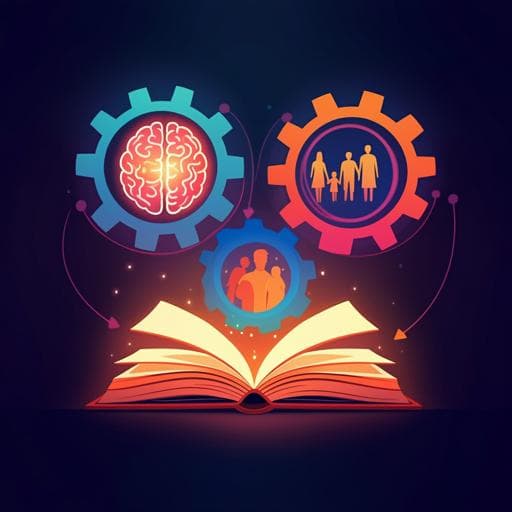
Education
Understanding the influence of children's mental health, cognitive development, and environmental factors on learning outcomes in Chile
G. Gómez, M. Rivas, et al.
This groundbreaking study, conducted by Gabriela Gómez and colleagues, delves into the crucial links between children's mental health, cognitive development, and social backgrounds, revealing how these factors influence learning outcomes in Chilean first graders. Discover how working memory and social-emotional behavior significantly impact academic success in reading and math, highlighting the need for a holistic view on child development.
~3 min • Beginner • English
Introduction
The study addresses how children’s mental health (socioemotional behavior), cognitive development (visuospatial working memory), and social background jointly relate to early learning outcomes in Chile. Building on WHO’s holistic definition of mental health and life course theory, the authors note that early childhood experiences have long-term effects on academic and social development. Prior work shows cognitive processes, especially working memory, are linked to reading and mathematics, and that mental health difficulties (e.g., ADHD, anxiety) undermine academic performance. The Chilean context features high social inequality and educational segregation, making an integrated analysis of mental health, cognition, and environment particularly relevant. The purpose is to move beyond two-dimensional analyses and test a comprehensive model at the start of primary school, examining interactions among SEB, VWM, maternal education, sex, and learning (reading and mathematics).
Literature Review
Evidence indicates 10–20% prevalence of childhood mental health difficulties globally, with links to poorer academic achievement (e.g., depression, anxiety, ADHD). Cognitive development—especially working memory—supports learning across domains and predicts mathematics and reading, even after controlling IQ and SES. Working memory relates bidirectionally with academic skills and can be impaired by anxiety; social adversity also affects cognition. Most research comes from Western, anglophone contexts. In Latin America, studies often examine environmental or cognitive predictors separately, with fewer integrated models linking mental health, cognition, and achievement together. In Chile, social inequality and school segregation correlate with achievement gaps and mental health disparities; prior work shows differences by school type and child sex in internalizing/externalizing symptoms. There is a gap in comprehensive models that simultaneously incorporate mental health, cognitive development, and social background to explain learning outcomes at school entry.
Methodology
Design: Quantitative, cross-sectional study applying multilevel structural equation modeling to assess interactions among socioemotional behavior (SEB), visuospatial working memory (VWM), and learning outcomes, controlling for sex and maternal education. Causal inference is not supported by the design.
Setting and participants: 610 first-grade children (300 males, 310 females; mean age 7.05 years, SD 0.476; range 5.82–10.64) from 39 public schools in the O'Higgins region, Chile. All sampled schools were public due to their prevalence in the region. Recruitment obtained approvals from regional authorities and school principals.
Measures:
- Socioemotional behavior (SEB): Parent-report Strengths and Difficulties Questionnaire (SDQ-P; 25 items; 0–2 scale). Subscales: emotional symptoms, conduct problems, hyperactivity, and peer problems. Spanish parent version for ages 4–17. Validity and reliability supported in prior research and in Chile; Cronbach’s alpha = 0.70 in this sample. Subscales standardized to mean 0, SD 1.
- Learning outcomes: Reading and mathematics clusters from Woodcock–Johnson IV Tests of Achievement (Spanish). Reading: Letter-Word Identification and Passage Comprehension (median reliability 0.94). Mathematics: Applied Problems and Calculation (mean reliability 0.96). Both clusters standardized to mean 0, SD 1.
- Visuospatial working memory (VWM): Virtual Corsi Block Tapping Test (CBTT). Children reproduce sequences of blocks; sequences increase in length until failure. Score is total correct sequences (max 12); standardized for analyses.
- Social background covariates: Maternal education (0–19 years); sex (1 = female, 0 = male).
Procedures: Data collected Sept–Dec 2019. Parent SDQ-P administered during teacher/parent meetings with trained assistants available. Child assessments (WJ IV ACH and CBTT) administered individually at school in quiet spaces; assent obtained. Ethical approvals and informed consent procedures followed institutional protocols.
Analytic strategy: Conducted in R 4.0.4. Computed descriptive statistics, Pearson correlations, and intraclass correlations (ICCs). Estimated two analogous multilevel path models (for reading and for mathematics) using lavaan, with students nested within schools. Modeled random intercepts at the school level for variables with ICC > 5% (reading, mathematics, CBTT). Each model included direct effects of CBTT, SEB subscales, sex, and maternal education on the test score; direct effects of CBTT on each SEB subscale; and direct effects of sex on CBTT and SEB. Residual covariances were specified among SEB subscales. Model fit evaluated with CFI (≥0.95), RMSEA (≤0.05), SRMR (≤0.05), plus inspection of residual correlations. Missing data (4.3%) handled by listwise deletion.
Key Findings
Descriptives/ICCs (Table 1): Maternal education mean 11.50 years (SD 3.68). Standardized distributions for reading (ICC 7.6%), mathematics (ICC 8.4%), CBTT (ICC 6.7%). SEB ICCs were low (≤1.8%), indicating little between-school variance.
Correlations (Table 2): All four SEB measures correlated negatively with mathematics; three with reading (conduct problems showed mixed relations). Strongest SEB–achievement correlations: hyperactivity with reading r = -0.23 (p < 0.001) and mathematics r = -0.22 (p < 0.001). CBTT correlated positively with achievement (math r = 0.25***; reading r = 0.16***), and negatively with SEB (largest with conduct problems r = -0.18***). Maternal education positively correlated with reading and mathematics and negatively with emotional and peer problems. Sex correlated with SEB (girls lower hyperactivity r = -0.22***; small negative with conduct and emotional problems).
Model fit (Table 3): Reading model: χ2(8) = 19.08, p = 0.014, CFI = 0.98, RMSEA = 0.049 (90% CI 0.020–0.077), SRMRwithin = 0.038, SRMRbetween = 0.151. Mathematics model: χ2(8) = 18.77, p = 0.016, CFI = 0.98, RMSEA = 0.048 (90% CI 0.019–0.077), SRMRwithin = 0.038, SRMRbetween = 0.092. Local fit acceptable; small residual correlations remained with maternal education and two SEB subscales.
Path results – Reading (Fig. 2):
- CBTT showed a positive direct effect on reading: β = 0.127 (p < 0.01) and negative effects on all SEB subscales, yielding an indirect positive effect via SEB of β = 0.035 (p < 0.01); total CBTT effect on reading β = 0.162 (p < 0.001).
- SEB effects on reading: hyperactivity β = -0.232***; peer problems β = -0.125**; conduct problems small positive β = 0.104*; emotional problems not significant.
- Maternal education had a positive direct effect: ≈ 0.04 increase in reading per additional year of education.
- Sex predicted SEB (girls lower hyperactivity and conduct problems) but was not reported as a direct predictor of reading.
Path results – Mathematics (Fig. 3):
- CBTT had a positive direct effect on mathematics: β = 0.202 (p < 0.001) and negative effects on SEB, giving an indirect positive effect via SEB of β = 0.037 (p < 0.01); total CBTT effect β = 0.240 (p < 0.001).
- SEB effects on mathematics: hyperactivity β = -0.158***; peer problems β = -0.160***; emotional and conduct problems not significant.
- Maternal education positive: ≈ 0.021 increase in mathematics per additional year of education.
- Sex predicted SEB (girls lower hyperactivity β = -0.436 and conduct β = -0.225).
Variance decomposition: School-level variance accounted for ~8.9% of reading and ~7.1% of mathematics variance; CBTT school-level variance ~6.6–7.1%. SEB subscales showed negligible between-school variance. Residual covariances among SEB subscales were significant, indicating shared variance beyond CBTT and sex.
Discussion
The integrated multilevel path models demonstrate that learning at the start of primary school is shaped by intertwined cognitive, socioemotional, and social background factors. Visuospatial working memory contributes directly to reading and mathematics and indirectly via better socioemotional functioning (lower hyperactivity, conduct, and peer problems). Hyperactivity and peer problems consistently undermine both reading and mathematics, aligning with literature on externalizing symptoms and academic outcomes. Emotional problems did not relate to reading or mathematics, suggesting internalizing symptoms may not impair performance at this developmental stage or within these measures. Conduct problems showed a small positive association with reading but were unrelated to mathematics, highlighting nuanced and domain-specific effects. Maternal education, a proxy for social background, exerted independent positive effects on both learning domains, consistent with structural educational inequalities in Chile. The results support life course theory: early cognitive and socioemotional capacities, embedded in social context, cumulatively shape learning trajectories. The comprehensive model, tested in a Latin American setting, advances understanding beyond two-variable associations by quantifying direct and indirect pathways among cognition, SEB, and achievement.
Conclusion
This study contributes an integrated model linking children’s mental health (SEB), visuospatial working memory, and social background to early reading and mathematics in Chile. Key contributions include: (a) evidence that VWM affects achievement both directly and indirectly through SEB; (b) consistent negative impacts of hyperactivity and peer problems on learning; (c) positive effects of maternal education on achievement; and (d) limited roles for emotional and conduct problems in mathematics, with conduct showing a small positive link to reading. Findings underscore the importance of early promotion of positive mental health within schools and policies, consistent with life course perspectives on cumulative development. Future research should expand to diverse school types, incorporate broader age ranges, and employ longitudinal designs to test developmental changes and causal pathways; further, targeted examination of emotional versus conduct problems and their domain-specific relations to learning is warranted.
Limitations
- Cross-sectional design limits causal inference.
- Sample restricted to public schools in a single Chilean region, with limited social background diversity; generalizability to private or subsidized schools and other regions may be limited.
- Narrow age range (first grade); developmental changes across later grades were not examined.
- Some between-school variance remained in achievement and CBTT, while SEB showed minimal school-level variance; unmeasured contextual factors may exist.
- Listwise deletion for 4.3% missing data may introduce bias if data were not missing completely at random.
Related Publications
Explore these studies to deepen your understanding of the subject.







